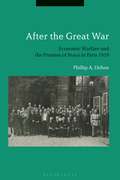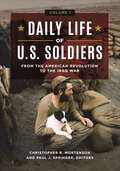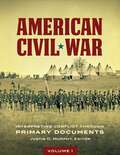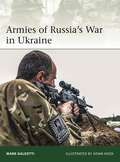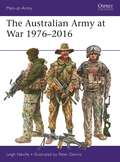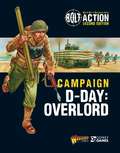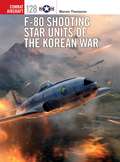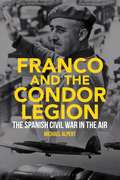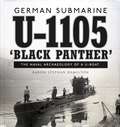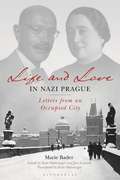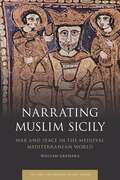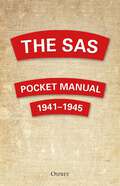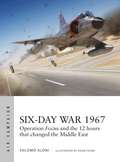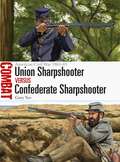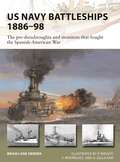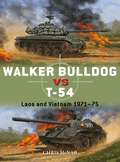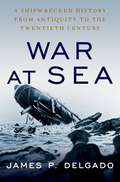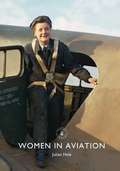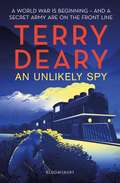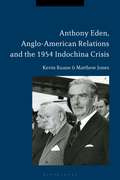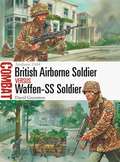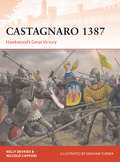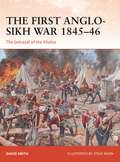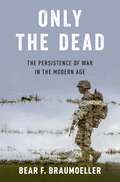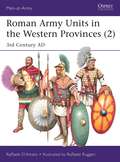- Table View
- List View
After the Great War: Economic Warfare and the Promise of Peace in Paris 1919
by Phillip DehneAt the Paris Peace Conference of 1919, the international community came together to find a way forward in the aftermath of the First World War. The conference is often judged a failure, as the resulting Treaty of Versailles did not bring long-term peace with Germany. By following the activities of British delegate and wartime Minister of Blockade Lord Robert Cecil, this book examines the struggles and successes of the conference, as delegates from around the world grappled with the economic, political and humanitarian catastrophes overwhelming Europe in 1919. After the Great War describes, for the first time, the significant role of economic warfare at the Peace Conference and in the post-war settlement. Lord Cecil's sometimes difficult partnership with US President Woodrow Wilson forged a new, permanent, international diplomatic organization – the League of Nations – and supplied it with the power to create collective blockades against aggressive states. Leaders of the Allied economic war before the Armistice became, in Paris, leaders of humanitarian-minded international outreach to their former enemies in Germany and Austria. After the Great War promotes a new understanding of these underappreciated internationalists in Paris, many of whom transitioned into leading the League of Nations even before the Peace Conference ended. Often derided as an idealistic fantasy, international peace enforced by economic sanctions appeared a realistic possibility when the Treaty was signed at the end of June 1919.
Daily Life of U.S. Soldiers [3 volumes]: From the American Revolution to the Iraq War [3 volumes]
This ground-breaking work explores the lives of average soldiers from the American Revolution through the 21st-century conflicts in Afghanistan and Iraq.What was life really like for U.S. soldiers during America's wars? Were they conscripted or did they volunteer? What did they eat, wear, believe, think, and do for fun? Most important, how did they deal with the rigors of combat and coming home? This comprehensive book will answer all of those questions and much more, with separate chapters on the American Revolution, the War of 1812, the Mexican-American War, the Civil War, the Indian Wars, the Spanish-American War, World War I, World War II in Europe, World War II in the Pacific, the Cold War, the Korean War, the Vietnam War, the Persian Gulf War, the Afghanistan War and War on Terror, and the Iraq War.Each chapter includes such topical sections as Conscription and Volunteers, Training, Religion, Pop Culture, Weaponry, Combat, Special Forces, Prisoners of War, Homefront, and Veteran Issues. This work also examines the role of minorities and women in each conflict as well as delves into the disciplinary problems in the military, including alcoholism, drugs, crimes, and desertion. Selected primary sources, bibliographies, and timelines complement the topical sections of each chapter.
American Civil War [2 volumes]: Interpreting Conflict through Primary Documents [2 volumes]
By providing detailed analyses of Civil War primary sources, this book will help readers to understand the history of the bloodiest of all American conflicts.This meticulously curated collection of primary source documents covers every aspect of the American Civil War, from its origins to its bloody engagements, all the way through the Reconstruction period. With approximately 300 primary sources, this comprehensive set includes orders and reports of significant battles, political debates and speeches, legislation, court cases, and literary works from the Civil War era. The documents provide insight into the thinking of all participants, drawing upon a vast range of sources that offer both a Northern and Southern perspective.The book gives equal treatment to the Eastern and Western Theaters and to Union and Confederate sources, and the primary sources are presented in chronological order, making it easy for readers to compare and contrast documents as the key events of the conflict unfold. Each primary source begins with an introduction that sets the document in its proper context and concludes with an analysis of the document that will help students to understand the document's significance.
Armies of Russia's War in Ukraine (Elite)
by Mark GaleottiIn February 2014, street protests in Kiev and other Ukrainian cities led to the ousting of the Russian-backed President Yanukovych. The so-called Euromaidan Revolution saw many changes to Ukraine's constitution, but the violent reaction in the east and south of the country led to armed counter-revolution, unofficially backed by Russia.This conflict is the essential example of Russia's new policy of 'hybrid warfare', which blends propaganda, misinformation, and the deployment of 'deniable' Special Forces and regular troops alongside proxies and mercenaries to achieve its strategic ends. Using his extensive contacts in both Russia and Ukraine, and access to a mass of official and unofficial sources, Mark Galeotti presents a thorough and intriguing primer on all the forces involved in the ongoing conflict in Ukraine. Supported by specially commissioned artwork, he analyses both the progress of the war, and what it teaches us about Russia's current military capabilities.
The Australian Army at War 1976–2016 (Men-at-Arms)
by Leigh NevilleSince the end of their involvement in the Vietnam War, the Australian Army has been modernized in every respect. After peacekeeping duties in South-East Asia, Africa and the Middle East in the 1980s–90s, 'Diggers' were sent to safeguard the newly independent East Timor from Indonesian harassment in 1999, and to provide long-term protection and mentoring since 2006. Australian Army units have served in the US-led wars in Iraq and Afghanistan, and Australian Special Forces are currently operating alongside US and British elements against ISIS in northern Iraq. During these campaigns the Australian SAS Regiment and Commandos have fully matured into 'Tier 1' assets, internationally recognized for their wide range of capabilities. The book, written by an Australian author who has written extensively about modern warfare, traces the development of the Army's organization, combat uniforms, load-bearing equipment, small arms and major weapon systems using specially commissioned artwork and photographs.
Bolt Action: Campaign: D-Day: Overlord (Bolt Action)
by Warlord GamesFrom the scaling of Pointe-du-Hoc and the assault on Pegasus Bridge, to the landings on the Utah, Omaha, Gold, Juno, and Sword beaches, this new Campaign Book for Bolt Action allows players to take command of the Allied Forces or those of the defending Axis. Featuring new linked scenarios, rules, troop types, and Theatre Selectors, this volume provides plenty of options for both novice and veteran players looking to recreate these famous battles and begin the liberation of Europe.
F-80 Shooting Star Units of the Korean War (Combat Aircraft)
by Warren ThompsonBuilt within a 180-day time limit in 1943, the F-80 Shooting Star first saw service in Italy in the final year of World War 2, and consequently was sent to bases in the US, Europe and the Far East after VJ Day. It was the latter groups based in Japan that initially bore the brunt of the early fighting in Korea, engaging MiG-15s in the world's first jet-versus-jet combat. Flown principally by the 8th and 49th Fighter Bomber Wings, the F-80 served until the end of the war, completing an astonishing 98,515 combat sorties, shooting down 17 aircraft (including three of the vastly superior MiG-15s), dropping over 33,000 tons of bombs, and firing over 80,000 air-to-ground rockets. Aside from the fighter-bomber Shooting Stars, the ultra-rare, but heavily used, photo-reconnaissance RF-80A saw extensive use in the frontline in Korea as a replacement for the vulnerable RF-51D. Filled with first-hand accounts and rare colour photographs taken by the veterans themselves, this is the engrossing story of the pioneering F-80 Shooting Star.
Franco and the Condor Legion: The Spanish Civil War in the Air
by Michael AlpertThe Spanish Civil War was fought on land and at sea but also in an age of great interest in air warfare and the rapid development of warplanes. The war in Spain came a turning point in the development of military aircraft and was the arena in which new techniques of air war were rehearsed including high-speed dogfights, attacks on ships, bombing of civilian areas and tactical air-ground cooperation. At the heart of the air war were the Condor Legion, a unit composed of military personnel from Hitler's Germany who fought for Franco's Nationalists in Spain. In this book, Michael Alpert provides the first study in English of the Spanish Civil War in the air. He describes and analyses the intervention of German, Italian and Soviet aircraft in the Spanish conflict, as well as the supply of aircraft in general and the role of volunteer and mercenary airmen. His book provides new perspectives on the air war in Spain, the precedents set for World War II and the possible lessons learnt.
German submarine U-1105 'Black Panther': The naval archaeology of a U-boat
by Aaron Stephan HamiltonNow in its final resting place at the bottom of the Potomac River in Maryland, the U-Boat U-1105 is unique among German World War II submarines. Technologically innovative, it was the only U-Boat to conduct a wartime patrol while equipped with the snorkel, GHG Balkon passive sonar and a rubberized coating known as Alberich designed to reduce its acoustic signature and hide from Allied sonar. After the end of World War II, it was the subject of instense testing and evaluation by the Allies, before finally being sunk to the bottom of the Potomac River.This highly illustrated book uses many new and previously unpublished images to tell the full story of this remarkable U-Boat, evaluating the effectiveness of its late war technologies, document its extensive postwar testing and detail all the features still present on the wreck site today.
Life and Love in Nazi Prague: Letters from an Occupied City
by Marie BaderPrague, 1940-1942. The Nazi-occupied city is locked in a reign of terror under Reinhard Heydrich. The Jewish community experience increasing levels of persecution, as rumours start to swirl of deportation and an unknown, but widely feared, fate. Amidst the chaos and devastation, Marie Bader, a widow age 56, has found love again with a widower, her cousin Ernst Löwy. Ernst has fled to Greece and the two correspond in a series of deeply heartfelt letters which provide a unique perspective on this period of heightening tension and anguish for the Jewish community. The letters paint a vivid, moving and often dramatic picture of Jewish life in occupied Prague, the way Nazi persecution affected Marie, her increasingly strained family relationships, as well as the effect on the wider Jewish community whilst Heydrich, one of the key architects and executioners of the Holocaust and Reich Protector in Bohemia and Moravia, established the Theresienstadt ghetto and began to organize the deportation of Jews. Through this deeply personal and moving account, the realities of Jewish life in Heydrich's Prague are dramatically revealed.
Narrating Muslim Sicily: War and Peace in the Medieval Mediterranean World (Early and Medieval Islamic World)
by William GranaraIn 902 the last Byzantine stronghold in Sicily fell, and the island would remain under Muslim control until the arrival of the Normans in the eleventh century. Drawing on a lifetime of translating and linguistic experience, William Granara here focuses on the various ways in which medieval Arab historians, geographers, jurists and philologists imagined and articulated their ever-changing identities in this turbulent period. All of these authors sought to make sense of the island's dramatic twists, including conquest and struggles over political sovereignty, and the painful decline of social and cultural life. Writing about Siqilliya involved drawing from memory, conjecture and then-current theories of why nations and people rose and fell. In so doing, Granara considers and translates, often for the first time, a vast range of primary sources - from the master chronicles of Ibn al-Athir and Ibn Khadun to biographical dictionaries, geographical works, legal treatises and poetry - and modern scholarship not available in English. He charts the shift from Sicily as 'warrior outpost' to vital and productive hub that would transform the medieval Islamic world, and indeed the entire Mediterranean.
The SAS Pocket Manual: 1941-1945
by Christopher WesthorpThe Special Air Service was the brainchild of Scots Guards' officer Lieutenant David Stirling, serving with No 8 Commando. He advocated a specially organised, specially equipped and specially trained unit dedicated to the 'unrelenting pursuit of excellence' that could act covertly and operate behind enemy lines to gain intelligence, destroy enemy aircraft and attack their supply and reinforcement routes.The 1st SAS Regiment was officially designated after successful raids against enemy airfields in the Middle East in 1941-1942. In May 1943 a 2nd SAS Regiment was raised in Algeria and would also serve in Sicily and Italy. SAS troopers were at the forefront of the action on D-Day, serving behind the enemy lines, assisting the French Resistance in diversionary attacks and in support of Allied armies. The SAS served with great distinction through 42 significant actions in Belgium, the Netherlands and Germany until the end of the war in Europe.This new addition to the bestselling Conway pocket-book series is compiled from wartime and post-war memorandums, manuals and documents. They include unit after-action reports and lecture notes from the centres used to train special services soldiers, gathered from the Liddell Hart Military Archive, National Archives, wartime periodicals and post-war memoirs. The book covers: - training methods - weapons handling - fieldcraft - sabotage training - operations in North Africa and the Middle East (1941–1942), Sicily and Italy (1943) and France (1944–1945)
Six-Day War 1967: Operation Focus and the 12 hours that changed the Middle East (Air Campaign)
by Shlomo AloniOn one day in June, the balance of air power in the Middle East was turned upside down by perhaps the most ruthlessly effective air superiority campaign in history – Operation Moked, or Focus. In 1967, the Israeli Air Force was outnumbered more than two to one by the jets of hostile Egypt, Syria, Jordan and Iraq. Operation Focus was Israel's ingenious strike plan to overturn the balance. At 0745hrs on June 6, Israeli jets hit Egypt's airfields simultaneously, first bombing runways and then strafing aircraft. Another 20 follow-up missions were already in the air, initially scheduled to hit every five minutes. This new history of Operation Focus explains how the concept for Focus was devised and meticulously planned, the astonishing rate of serviceability and turnaround speed it required from ground crews, and how the relentless tempo of strikes shattered one air force after another. It is the story of how Israel's victory in the Six-Day War began with a single, shocking day.
Union Sharpshooter vs Confederate Sharpshooter: American Civil War 1861–65 (Combat)
by Gary YeeDuring the American Civil War, the Union and the Confederacy both fielded units of sharpshooters. Sometimes equipped with firearms no better than those of their infantry brethren, they fought in a manner reminiscent of Napoleonic-era light infantry. Siege warfare placed a premium on marksmanship and the sharpshooter became indispensable as they could drive artillerymen from their guns. They could also become expert scouts and, for the Confederacy, impressive raiders – one raid netted almost 250 prisoners. Initially, Union marksmen enjoyed the upper hand, but as the Confederates began raising and training their own sharpshooters, they proved themselves as worthy opponents. In this study, Gary Yee, an expert in firearms of the period, assesses the role played by sharpshooters in three bloody clashes at the height of the American Civil War – the battle of Fredericksburg, the siege of Vicksburg, and the siege of Battery Wagner.
US Navy Battleships 1886–98: The pre-dreadnoughts and monitors that fought the Spanish-American War (New Vanguard)
by Brian Lane HerderAfter the American Civil War, the US Navy had been allowed to decay into complete insignificance, yet the commissioning of the modern Brazilian battleship Riachuelo and poor performance against the contemporary Spanish fleet, forced the US out of its isolationist posture towards battleships. The first true US battleships began with the experimental Maine and Texas, followed by the three-ship Indiana class, and the Iowa class, which incorporated lessons from the previous ships. These initial ships set the enduring US battleship standard of being heavily armed and armoured at the expense of speed. This fully illustrated study examines these first six US battleships, a story of political compromises, clean sheet designs, operational experience, and experimental improvements. These ships directly inspired the creation of an embryonic American military-industrial complex, enabled a permanent outward-looking shift in American foreign policy and laid the foundations of the modern US Navy.
Walker Bulldog vs T-54: Laos and Vietnam 1971–75 (Duel)
by Chris McNabDuring the Vietnam War, both the United States and the Soviet Union supplied all manner of weapon systems to the opposing sides, including tanks and armoured vehicles. Two tanks in particular took momentary prominence in the later years of the conflict. On the South Vietnamese side, it was the US M41 Walker Bulldog; for the communist North Vietnamese, the Soviet-supplied T-54 main battle tank was the core of their armoured power. In their first major engagement, during Operation Lam Son 719 (February–March 1971), it was the Walker Bulldog in the ascendant, but in later battles the T-54s inflicted heavy losses on their lighter opponents, taking the advantage through their superior manoeuvrability and gunnery. Illustrated with full-colour artwork as well as rare and revealing photographs from both sides, this book studies these two iconic tanks in Vietnamese service, examining how their differing designs and fighting doctrines affected their performance in this unique theatre of combat.
War at Sea: A Shipwrecked History from Antiquity to the Twentieth Century
by James P. DelgadoThe ocean is humanity's largest battlefield. Resting in its depths lie the lost ships of war, spanning the totality of human history. Many wrecks are nameless, others from more recent times are remembered, honored even, as are the battles that claimed them, like Actium, Trafalgar, Tsushima, Jutland, Pearl Harbor, and Midway. Underwater exploration is increasingly discovering long-lost warships from the deepest parts of the ocean, revealing a vast undersea museum that speaks to battles won and lost, service, sacrifice, and the human costs of warfare. War at Sea is a dramatic global tour of this remote museum and other formerly lost traces of humanity's naval heritage. It is also an account by the world's leading naval archaeologist of how underwater exploration has discovered these remains, thus resolving mysteries, adding to our understanding of the past, and providing intimate details of the experience of naval warfare. Arranged chronologically, the book begins with the warships and battles of the ancient Egyptians, Phoenicians, Greeks, Romans, and Chinese, and then progresses through three thousand years to the lost ships of the Cold War. James Delgado, who has personally explored, dived, and studied a number of the wrecks and sites in the book, provides insights as an explorer, archaeologist, and storyteller. The result is a unique and compelling history of naval warfare. From fallen triremes and galleons to dreadnoughts, aircraft carriers, and nuclear submarines, this book vividly brings thousands of years of naval warfare to life.
Women in Aviation (Shire Library)
by Julian HaleThis title explores the scope of women's activities in aviation, from the time of the Wright Brothers to the present day. After highlighting the earliest female aviators, as well as the trailblazers of the inter-war period such as Amy Johnson and Amelia Earhart, the book goes on to examine the experience of women in aviation during the Second World War, including those flying with the Air Transport Auxiliary and the American Women Airforce Service Pilots. The post-war years are also covered and the title emphasises the growth in women's participation in civil and military spheres of aviation – by the last decades of the twentieth century, women had progressed even further, undertaking many of the jobs previously reserved for men, including space flight and combat flying. From the earliest women to obtain pilot's licenses to the female astronauts of the modern day, this is a concise introduction to the development of British and American women's roles in aviation.
An Unlikely Spy
by Terry DearyThrilling historical adventure from Terry Deary, the 'outstanding children's non-fiction author of the 20th century' (Books For Keeps)This brand new, exciting adventure from bestselling Horrible Histories author Terry Deary brings the Second World War to life. Perfect for fans of Michael Morpurgo and John Boyne. World War II has begun. Brigit has been evacuated to Wales from her home near the aeroplane factories of Coventry. But when it's revealed that her father is German, Brigit runs away to join her mother in a very special training camp, where Churchill is building a secret army of spies and saboteurs known as the Special Operations Executive.Brigit and her mother soon find themselves on the front line in Nazi-occupied France, where they search for double agents and meet with danger at every turn in their efforts to support the French resistance. But no-one will suspect Brigit is a spy, will they? After all, who would suspect a child?Featuring characters from The Silver Hand, this page-turning adventure sheds new light on the Second World War and will have readers gripped from start to finish.
Anthony Eden, Anglo-American Relations and the 1954 Indochina Crisis
by Kevin Ruane Matthew JonesIn the spring of 1954, after eight years of bitter fighting, the war in Vietnam between the French and the communist-led Vietminh came to a head. With French forces reeling, the United States planned to intervene militarily to shore-up the anti-communist position. Turning to its allies for support, first and foremost Great Britain, the US administration of Dwight D. Eisenhower sought to create what Secretary of State John Foster Dulles called a “united action” coalition. In the event, Winston Churchill's Conservative government refused to back the plan. Fearing that US-led intervention could trigger a wider war in which the United Kingdom would be the first target for Soviet nuclear attack, the British Foreign Secretary, Anthony Eden, was determined to act as Indochina peacemaker – even at the cost of damage to the Anglo-American “special relationship”.In this important study, Kevin Ruane and Matthew Jones revisit a Cold War episode in which British diplomacy played a vital role in settling a crucial question of international war and peace. Eden's diplomatic triumph at the 1954 Geneva Conference on Indochina is often overshadowed by the 1956 Suez Crisis which led to his political downfall. This book, however, recalls an earlier Eden: a skilled and experienced international diplomatist at the height of his powers who may well have prevented a localised Cold War crisis escalating into a general Third World War.
British Airborne Soldier vs Waffen-SS Soldier: Arnhem 1944 (Combat)
by David GreentreeOperation Market Garden was an Allied plan to try and end the war before the end of 1944, and relied on landing airborne troops to secure bridges over the Rhine bridges in the Netherlands. Critical to this plan were the glider troops of Britain's 1st Airlanding Brigade. Short on heavy weapons and not trained in street fighting, the glider troops were meant to secure and defend the Allied perimeter around Arnhem as the parachute brigades fought their way into the city. Facing the airborne forces were understrength Waffen-SS units that were hastily formed into ad hoc battle groups, some supported by armour. The troops on both sides would have their tactical flexibility and powers of endurance tested to the limit in the bitter actions that ensued. Employing first-hand accounts and drawing upon the latest research, David Greentree tells the story of the glider troops' dogged defence of the Allied perimeter at Arnhem, and the Waffen-SS forces' efforts to overcome them.
Castagnaro 1387: Hawkwood’s Great Victory (Campaign)
by Kelly DeVries Niccolò CapponiThe battle of Castagnaro, fought on 11 March 1387 between the Veronese and the Paduans, is one of the most famous Italian medieval conflicts in the English-speaking world. This is thanks in no small part to the exploits of the renowned English mercenary (or condottiero) captain, Sir John Hawkwood. Commanding the Paduan army, he led them to a stunning victory.This new study challenges the conventional story of the battle, relocating it to the other side of the Adige River, and showing that Hawkwood was no mere disciple of his previous commander, the Black Prince–he was a highly talented and intelligent general in his own right. Using specially commissioned full-colour artwork, this fascinating book shows how Hawkwood used his own acumen, and the training, skills, and discipline of his very experienced condottieri, to defeat his opponents at Castagnaro.
The First Anglo-Sikh War 1845–46: The betrayal of the Khalsa (Campaign)
by David SmithThe First Anglo-Sikh War broke out due to escalating tensions between the Sikh Empire and the British East India Company in the Punjab region of India in the mid-nineteenth century. Political machinations were at the heart of the conflict, with Sikh rulers fearing the growing power of their own army, while several prominent Sikh generals actively collaborated with the East India Company.The British faced a disciplined opponent, trained along European lines, which fielded armies numbering in the tens of thousands. The war featured a number of closely contested battles, with both sides taking heavy losses. This fully illustrated study of the First Anglo-Sikh War tells the story of one of the major colonial wars of the nineteenth century, as the East India Company attempted to wrest control of the Punjab region from a Sikh Empire riven by infighting.
Only the Dead: The Persistence of War in the Modern Age
by Bear F. BraumoellerThe idea that war is going out of style has become the conventional wisdom in recent years. But in Only the Dead, award-winning author Bear Braumoeller demonstrates that it shouldn't have. With a rare combination of historical expertise, statistical acumen, and accessible prose, Braumoeller shows that the evidence simply doesn't support the decline-of-war thesis propounded by scholars like Steven Pinker. He argues that the key to understanding trends in warfare lies, not in the spread of humanitarian values, but rather in the formation of international orders--sets of expectations about behavior that allow countries to work in concert, as they did in the Concert of Europe and have done in the postwar Western liberal order. With a nod toward the American sociologist Charles Tilly, who argued that "war made the state and the state made war," Braumoeller shows argues that the same is true of international orders: while they reduce conflict within their borders, they can also clash violently with one another, as the Western and communist orders did throughout the Cold War. Both highly readable and rigorous, Only the Dead offers a realistic assessment of humanity's quest to abolish warfare. While pessimists have been too quick to discount the successes of our attempts to reduce international conflict, optimists are prone to put too much faith in human nature. Reality lies somewhere in between: While the aspirations of humankind to govern its behavior with reason and justice have had shocking success in moderating the harsh dictates of realpolitik, the institutions that we have created to prevent war are unlikely to achieve anything like total success--as evidenced by the multitude of conflicts in recent decades. As the old adage advises us, only the dead have seen the end of war.
Roman Army Units in the Western Provinces: 3rd Century AD (Men-at-Arms)
by Raffaele D’AmatoThe appearance of Roman soldiers in the 3rd century AD has long been a matter of debate and uncertainty, largely thanks to the collapse of central control and perpetual civil war between the assassination of Severus Alexander in 235 and the accession of the great Diocletian in 284. During those years no fewer than 51 men were proclaimed as emperors, some lasting only a few days. Despite this apparent chaos, however, the garrisons of the Western Provinces held together, by means of localized organization and the recruitment of 'barbarians' to fill the ranks. They still constituted an army in being when Diocletian took over and began the widespread reforms that rebuilt the Empire – though an Empire that their forefathers would hardly have recognized. Fully illustrated with specially chosen colour plates, this book reveals the uniforms, equipment and deployments of Roman soldiers in the most chaotic years of the Empire.
